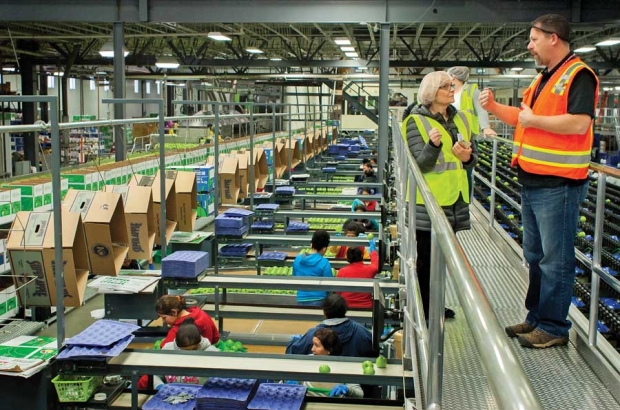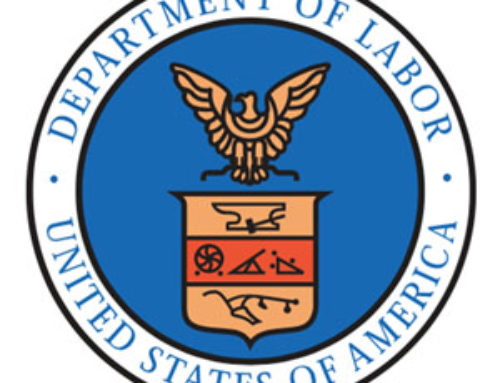
Rick Beecroft, right, of Monson Fruit Company leads food safety scientist Kathleen Glass of the University of Wisconsin-Madison Food Research Institute on a tour on December 10, 2015 in Selah, Washington. The packing house tour was to set up to help the group better understand challenges faced by the tree fruit industry to meet new food safety regulations. (Shannon Dininny/Good Fruit Grower)
Kathleen Glass started working at the University of Wisconsin-Madison Food Research Institute 30 years ago, studying various microbes — primarily those turning up in the meat and dairy industries — and assisting with food safety investigations.
She added her first fruit case last year with a Listeria monocytogenes outbreak in caramel apples.
Now, Glass and other researchers are working to better understand the needs of the tree fruit industry in order to help growers, packers and retailers meet new food safety regulations and ensure the safety of their products.
“The meat and dairy industries had problems 20 years ago. That’s really when we found our religion when it comes to food safety,” Glass said.
Fruit growers didn’t have as much to worry about then, she said, but the new regulations will require additional precautions.
“The learning curve will be much quicker than it was in other industries, just because they have the benefit of other industries’ mistakes,” she said.
Listeriosis
Each year, one in six people will be stricken with a food-borne illness, with Listeriosis being among the most serious.
The Listeria monocytogenes pathogen sickens some 1,600 people each year and is one of the leading causes of death related to food-borne illness: Some 20 to 30 percent of those who contract the illness die, an estimated 260 people annually.
Elderly people, those with compromised immune systems and women who are pregnant are most susceptible.
A couple of consecutive outbreaks with ready-to-eat meat products led to significant changes in cleaning and sanitation in that industry, Glass said, as well as the addition of growth inhibitors to meat products so that Listeria can’t grow during the normal shelf life.
The changes sparked a 42 percent decrease in cases from 1996 to 2012.
The World Health Organization estimates an infectious dose of Listeria at about 10,000 cells or more.
“Just a couple of Listeria in our food products probably is not going to make us sick. That means we need to focus on foods that support growth — perishable things you should refrigerate, those with the right amount of moisture and the right acidity level,” Glass told growers and packers at December’s Washington State Tree Fruit Association Annual Meeting in Yakima, Washington.
The case of the caramel apples
Investigators eventually tied the Jan. 6, 2015, Listeria outbreak to a specific supplier of Granny Smith and Gala apples in California, marking the first direct tie of fresh whole apples to a serious food safety outbreak.
But there were some novel things about the case, Glass said. Healthy children were getting sick from an unusual food source: caramel apples.
The apples were sanitized, dipped in hot caramel, and the pH of the apples was too low for minimum growth of the pathogen, which raised several questions.
Is this the work of a superbug? Are conditions present to allow growth? Could damage to the apple contribute?
Preliminary studies suggest that damage to apples could encourage microbial growth, Glass said. In this case, puncturing the apple with a stick allowed Listeria to translocate to the core.
In addition, deep depressions in apples may protect Listeria from hot caramel. Storage temperature also is an issue, with the apples stored at room temperature at retail, enabling Listeria growth.
Positive Listeria tests came back in several areas, including polishing brushes, drying brushes, a packing line drain, and the inside of an unpainted wooden bin at the packing house, said Kate Woods, vice president of the Northwest Horticultural Council.
This case, along with two other recalls of fresh whole apples in which no illnesses were reported, highlights the immediate need for hands-on training in packing houses and for additional research on industry best practices.
The federal requirements will likely create the need for changes, she said, “but we will not have to start from scratch. It’s adding to the things you already do.”
What’s known
Several things have been tried to control Listeria. However, none has been validated on a large scale, Glass said.
Ultraviolet light might not be effective if there are stems or shadowing on the apple, or if the quality of the apple is low. Chlorinated water at low levels is not known to reduce Listeria, though higher concentrations will do more.
“A lot of things may have been used in a laboratory setting and you can get a certain amount of kill, but what happens in a laboratory can be so different because we have more control,” she said. “Listeria is an insidious bug, and you’re going to have to keep looking where those niches are for concentrations. Find it and fix it.”
With that in mind, Glass and others toured packing houses, an orchard and an apple slicing facility following the annual meeting to get a better sense of the industry.
Claudia Coles, policy and external affairs advisor for the Washington State Department of Agriculture’s Food Safety and Consumer Services Division, used the tour as an opportunity to look for areas to target research funding.
“If there are preventive steps that can control avenues of concern, we want to look at those, rather than have some go to extreme steps of changing out equipment when it might not be necessary,” she said.
The group visited Monson Fruit Company in Selah, Washington. Glass joined the company’s regulatory compliance manager, Rick Beecroft, in a discussion about specific areas of the apple packing line that could pose risks for Listeria contamination, including a belt that carries apples through the dryer.
Glass recommended adding temperature sensors to the rollers to determine if the temperature is high enough — and the length of time long enough — to kill bacteria on the belt and on the product, as has been done at some other food processing companies.
If nothing else, she said, the area should be swabbed and tested in the morning and evening each day.
Beecroft liked the idea of adding a heat monitor. “We know this is a process that’s a certain risk,” he said. “That would be something that we may investigate further and pursue.”
Glass said it’s clear the industry is stepping up its efforts in the food safety arena and in environmental testing, which is the best way to determine if there’s an area of concern.
The problem is knowing if disinfectants are as effective as hoped.
“We have to try things that have been done elsewhere and apply things in different ways,” she said. “It’s a tough, tough thing, because they don’t have a great kill step. We don’t have any magic at this point, and more research is needed.”
That said, Glass added that the industry has made some phenomenal changes in terms of cleaning, sanitation, environmental testing and monitoring in the past 10 months.
“We have to walk before we run, but we have to start somewhere, and the industry really is working hard,” she said. “It’s not the end.” •
-by Shannon Dininny






nice piece on listeria…thanks…